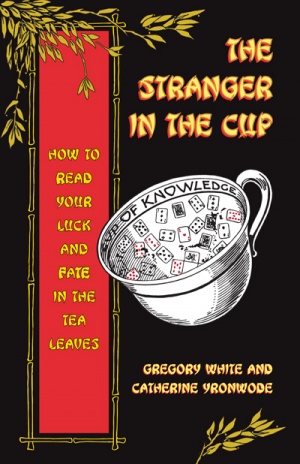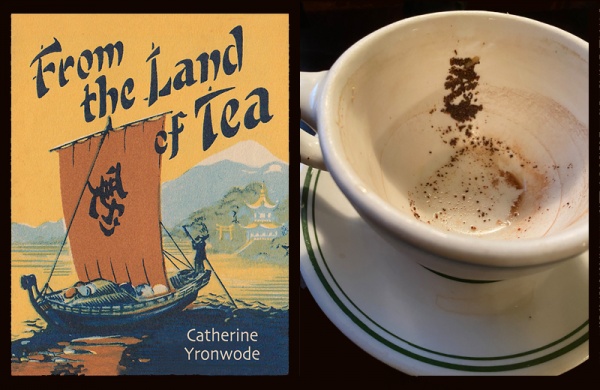Category:Instructions in Tasseomancy
From Mystic Tea Room




A question i am often asked is, "How did you learn to do tea leaf reading?"
As a child in the 1950s, i learned primarily from a particular older woman, a neighbor of ours, who was also a card reader and numerologist. She told me that i would become a professional psychic, and she taught me many things. Her name was Mrs. Hare.
My parents owned an antiquarian book shop. Around 1959, my mother, a librarian, decided to compile an annotated bibliography of cookbooks and recipe pamphlets that had been published in California. This was released in 1960 as "California in the Kitchen: An Essay Upon, and a Check List of, California Imprints in the Field of Gastronomy from 1870(?) - 1932."
As my mother's eager teen-aged helper, i scouted thrift stores for rare and obscure cookbooks, and brought her many a startling find. While searching through the piles of undervalued treasures at local Goodwill, Saint Vincent de Paul, and Salvation Army shops, i became fascinated with the illustrated recipe pamphlets issued by food companies from 1880 through 1940. Among these pamphlets there were many not published in California, and so of no interest to my mother's project, but i could not bear to see them left behind, and thus i began my life-long accumulation of such ephemera. Among these pamphlets i found quite a few issued by tea companies that contained instructions in tea leaf reading.
Around 1964, through one of those marvels of synchronicity which make life ever so interesting, my parents purchased the personal library of a female occultist and metaphysician who had recently died. They gave me the part-time job of cataloguing her books for resale. In going through the incredible collection of "The Mistress of the Lotus Lodge," i discovered her copies of the tasseomancy instruction books written by The Highland Seer, Cicely Kent, and Minetta -- and, carefully wrapped in with them, an Aynsley Nelros Cup of Fortune from 1904. This served as my introduction to the subject of marked fortune telling cups and saucers, and i have collected and used them for divination ever since.
My story is unusual, and few tea leaf readers who come after me will live the kind of life i have led, so rather than try to take you through my voyage of discovery, i will open a few doors for you on your own path toward tea leaf reading. In doing so, i will change the question from, "How did you learn to do tea leaf reading?" to "How is this system of divination transmitted?"
Here are the major paths of knowledge.
Contents |
Learn From Family and Friends
Divination by means of tea leaf reading is a long-cherished form of domestic fortune telling. It may be performed at home for oneself, family, or friends. For generations, learning to read the leaves from a cherished old grandmother or auntie was a tradition kept alive in many families, particularly those with cultural connections to Scotland, Ireland, or England. In a similar way, the reading of coffee grounds was transmitted within families of Greek, Turkish, and Arabic descent.
My childhood study with our neighbor, Mrs. Hare, was of this nature, and if you look at the section of this site that deals with tea leaf reading in art, you will see many examples of younger and older women leaning their heads together, inspecting the dregs of a cup of tea.
Learn from Company-Issued Instruction Booklets
Brief instructions in tea leaf reading come primarily from two sources -- tea leaf reading booklets issued by tea companies as promotions for the drinking of tea, and tea leaf reading booklets issued by pottery companies with their fortune telling tea cups, for the ease of understanding the unique designs and methods that are found on cups decorated with symbols from other divination systems, including astrology, cartomancy, numerology, and folkloric signs or omens.
The days of tea-companies issuing free pamphlets are long gone, but there are still fortune-telling cups issued with booklets -- and if you buy a vintage marked cup that has lost its instruction booklet, you can ask around for a copy, for which the charge will likely be modest.
Learn from a Professional Tea Leaf Reader
Over the years the oral transmission of the methods and "rules" of tea leaf reading travelled from Scotland, Ireland, England, and Wales to North America, Australia, New Zealand, and other regions of the world that were populated by English-speaking colonists. In the United States, close contact between enslaved African people and their enslavers led to a strong interest in these European methods among African American diviners, root doctors, and mediums. After Emancipation, many Black women read tea leaves professionally for clients, both Black and White.
When the Tea Room Movement took off in the early 20th century, the field for professional tea readers suddenly expanded. This was the era of the "free reading with every meal," a brief reading offered at many tea rooms in America. Some of these readers, like the mysterious Muriel of Detroit, Michigan, not only divined for clients at a tea room venue, but also sold a booklet explaining how she did it. Her booklet, "The Muriel Method of Tea-Leaf Reading," published in 1938, is one of the few that not only described how to read the leaves but how to dress, where to sit, and how to conduct oneself as a professional tasseomancer.
Although the days of the tea-room-subsidized "free reading" are mostly past, you can still learn from professional tea leaf readers who will brew a cup for you, allow you to drink it, and then read your leaves for you. If you express interest and offer to pay for lessons, they may teach you how it is done,.
Learn from Books, Cards, and Web Sites
Stand-alone books about tea leaf reading -- that is, those not issued by a tea company or a pottery manufacturer -- have been around since World War One. A small collection of such books can be assembled by browsing through my Bibliography of Books about Tasseomancy and then searching the internet. Some of the older books in the public domain are available for free download and also have been reprinted on paper. Newer books are, of course, available from the publishers and from local metaphysical shops and online merchants. When possible, do purchase your books from an independent store or from the publisher; it's just good sense.
During the early part of the 20th century, postcard and cigarette companies issued sets of instruction cards. Quite a few of these dealt with divination in general and with tea leaf reading in particular. These beautifully illustrated flash cards serve as a great introduction to the symbols, omens, and signs to be found in a cup of tea.
- Fortune Telling Postcards by Fred C. Lounsbury
- Fortune Telling Postcards by Bamforth
- Your Fortune in a Tea-Cup Postcards
The internet is a third source of written instruction in tea leaf reading. My article on How To Read Tea Leaves will help you get started, and you may also enjoy my Basic List of Tea Leaf Symbols on this site as well.
Finally, if you are looking for a good, inexpensive, heavily illustrated book of instructions in cup reading, i will not surprise you if i offer a plug for "The Stranger in the Cup: How to Read Your Luck and Fate in the Tea Leaves" by Gregory Lee White and catherine yronwode. This book offers a full dictionary of more than 800 tea leaf symbols, plus dozens of sample cup interiors that will show you exactly what the leaves reveal, and will guide you from beginner to expert cup reader in no time.
Learn by Reading for Yourself
After you set the scene by studying the readings given by others and through consultation with books, you will learn to interpret the leaves by reading for yourself. Now that you know that there are both traditional symbolic components and individual intuitive components to tea leaf reading, it's time to brew a cup of tea and read it! But before you go on to the page on How To Read Tea Leaves, allow me to share an example of how remarkable tea leaf reading can be.
In December 2020 i decided that in order to reach more people and to find some financial support for my work here at The Mystic Tea Room, i would open a Patreon account, where people could make small monthly donations to get access to bonus pages on tasseomancy, and, for a larger contribution, receive monthly packages of tea, tea leaf reading ephemera, and even vintage tea cups. I decided to call this project "From the Land of Tea," after a lovely little tea company booklet in my collection.
I scanned the art, cleaned it up, and launched "From the and of Tea" on Patreon on January 1st, 2021. People began to sign up almost at once. One week into the project, before i had even posted the link to the first bonus page for my Patrons, i drank my afternoon cup of tea, asking, "Will this be a success?" Here, without any photoshopping or fakery, is the tea cup, next to the logo i had designed.
Now you tell me -- if you were my tea leaf reader, how would you interpret that cup?
If you have a reply, please post it at the Lucky Mojo Forum in the thread called "Support Cat Yronwode on Patreon." Thank you.
catherine yronwode
curator, historian, and docent
The Mystic Tea Room
See Also
- Instructions in Tasseomancy
- How To Read Tea Leaves
- A Basic List of Tea Leaf Symbols
- Tea Leaf Reading Instruction Sheets and Booklets
- Tea Company Booklets on Tea and Tasseomancy
Subcategories
This category has only the following subcategory.
T
Pages in category "Instructions in Tasseomancy"
The following 10 pages are in this category, out of 10 total.
ABF |
F cont.HP |
TY |








